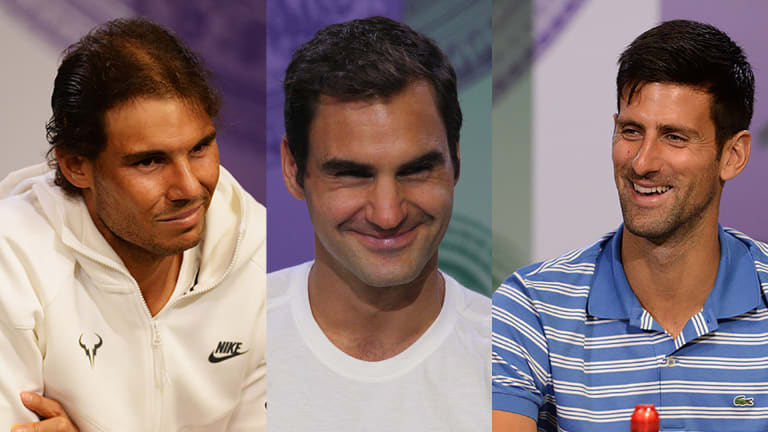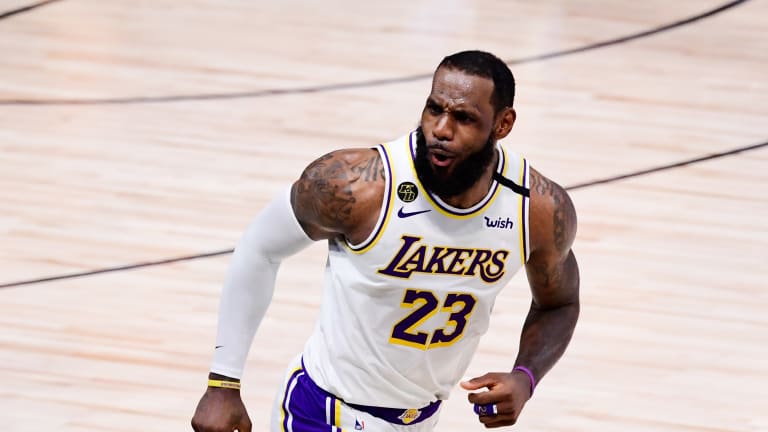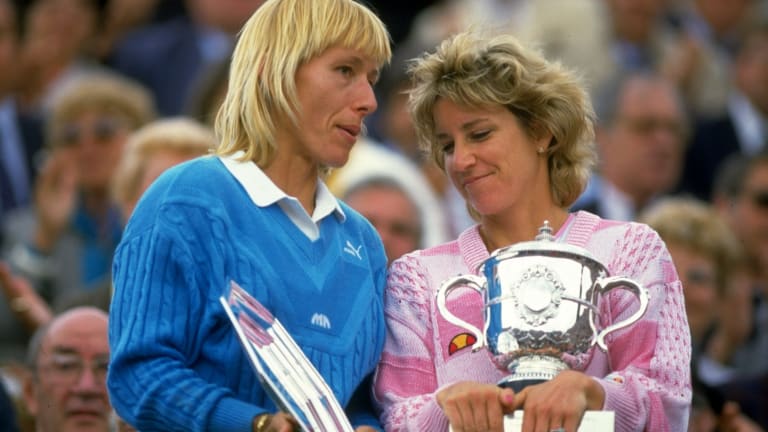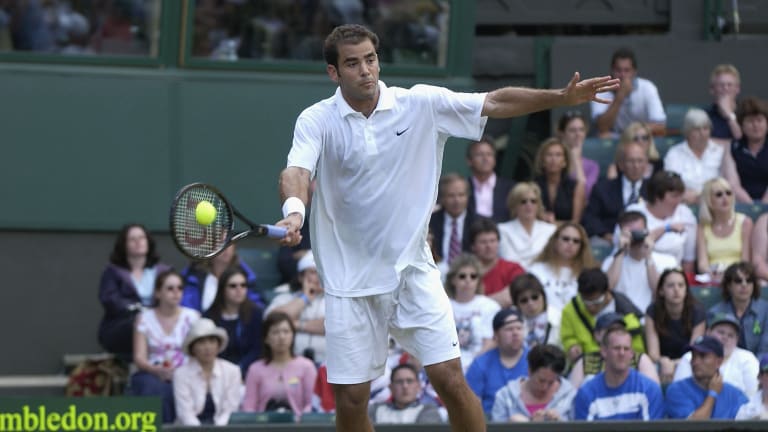The Rally: Is tennis' GOAT debate worth having in the first place?
Oct 16, 2020Roger Federer to headline “Battle of the World No.1s” at Australian Open’s inaugural Opening Ceremony
By TENNIS.com Dec 11, 2025Reaction to Roger Federer's Hall of Fame induction: "You're the most important sportsman of all time"
By TENNIS.com Nov 20, 2025Roger Federer is headed to the International Tennis Hall of Fame: 26 stats for his 2026 induction
By John Berkok Nov 19, 2025Mary Carillo joins Roger Federer with election into International Tennis Hall of Fame
By Associated Press Nov 19, 2025Jannik Sinner has now reached the final at all four Grand Slams and the ATP Finals this year
By John Berkok Nov 15, 2025Carlos Alcaraz, Jannik Sinner take their rivalry—and star power—on the road for 2026 “Super Match”
By Stephanie Livaudais Oct 24, 2025Roger Federer thrills tennis world with Shanghai Masters Celebrity doubles return
By David Kane Oct 10, 2025Roger Federer kicks off court speed debate: are fast courts going extinct?
By Pete Bodo Oct 09, 2025Roger Federer, Juan Martin del Potro lead 2026 nominees for the International Tennis Hall of Fame
By Associated Press Oct 01, 2025The Rally: Is tennis' GOAT debate worth having in the first place?
Rafael Nadal and Roger Federer did fans a favor by tamping down the talk on Sunday, but that talk will return eventually.
Published Oct 16, 2020
Advertising
In this week's edition of The Rally, Joel Drucker and Steve Tignor debate the value of greatest-ever debates.
Hi Joel,
Call it the GOAT debate that wasn’t: I was all set for the tennis media-sphere to explode on Sunday, after Rafael Nadal finally matched Roger Federer’s men’s-record 20 Grand Slam titles. It was a moment 15 years in the making, and one that seemed unlikely to happen just a few seasons ago. But aside from a few stray tweets favoring one of them over the other, it was mostly quiet on TV, and in my corner of Twitter. Which was nice.
I think Nadal and Federer did us a favor by defusing the debate as quickly as possible. Rafa focused on how much Roland Garros means to him, rather than the number 20; Federer tweeted about his respect and friendship for Nadal. They’ve learned that there’s plenty of glory to go around for both of them. And now that they’re tied for the first time, it was the perfect time for a truce.
Of course, even Roger and Rafa can’t kill the GOAT debate forever. It will simmer, and bubble, and percolate. And, if Novak Djokovic continues to close in on them, it will explode at some point, and likely go on forever. Right now, though, what I mostly see are debates about whether we should have GOAT debates in the first place. Can we really compare eras? Can we compare men and women? Isn’t it better just to appreciate each of the Big 3?

The Rally: Is tennis' GOAT debate worth having in the first place?
Advertising
Getty Images
I understand the reservations. The most damning one to me has to do with using Grand Slam titles as a measuring stick. How can you rate players by how many majors they’ve won—and that’s how Federer, Nadal, and Djokovic will be rated—when the best male player of the 1950s, Pancho Gonzalez, was banned from playing them for nearly his entire career?
But I still think GOAT debates have value, as long as stick to a couple of ground rules. One, keep it to the Open era, when everyone could play the majors. Two, stipulate that there are no right or wrong answers. Understanding that gives us the freedom to make our own cases for our own favorites, and that’s where it gets interesting.
Our fellow tennis writer Richard Evans always puts Lew Hoad’s name into the mix. Another, Steve Flink, maintains that Pete Sampras, at his best, was unbeatable. Joel, I’m guessing, would make a case for the importance of Jimmy Connors. For me, John McEnroe and Steffi Graf, in their own ways, played the most perfect tennis I’ve seen. Others might boost Billie Jean King or Arthur Ashe for their broader significance. And Federer, Nadal and Djokovic fans can each make strong claims why their guy is the best ever.
For all of its flaws, the GOAT debate is an accessible and popular framework for talking about tennis history. But it should be about you, the fan, and what you personally think, as much as it is about the players.
What do you think about herding GOATs, Joel?

The Rally: Is tennis' GOAT debate worth having in the first place?
Advertising
Getty Images
Hi Steve,
As far as the battle to determine the GOAT goes, please kindly consider me a conscientious objector. I don’t even think it’s the right question. Nor do I think it’s a particularly useful or deep way to engage with tennis history.
To pry into this more, significance and performance strike me as very different topics.
When it comes to significance, certainly the likes of King, Ashe and the Williams sisters made a social and cultural impact that went far beyond the lines. And when you look at boosting the popularity of tennis, such icons as Jack Kramer, Connors, Chris Evert, Bjorn Borg, McEnroe, and Andre Agassi were among those who did much. Granted, these are all great players too, worthy of evaluation for their exceptional deeds inside the lines.
Performance is different. Yes, it’s hard to compare eras in any sport. So why bother? And in tennis, a sport where the metrics have changed constantly for decades, this makes evaluation even more complicated, often to the point of absurdity.
Over the years, I’ve noticed that, quite swiftly, personal desires and emotions overtake analysis. One of my most useful phrases when pondering sports history is that the golden age ends when the athletes start getting younger than us. Jack Kramer, born in 1921, went to his grave thinking no one ever played the game better than his childhood hero, Ellsworth Vines (b.1911)—and accordingly, Kramer tossed far more compliments to Vines than he ever did to Rod Laver. The same premise extends to those who revere Hoad (b. 1934—four years before Laver, who also worships him), a particularly appealing notion given that great Aussie’s comet-like career.
A parallel comes in the realm of pop music. Many times, I’ve encountered older Baby Boomers who refuse to acknowledge the quality or greatness of any band that made its mark after the 1970 breakup of The Beatles. And we know that no matter how many titles LeBron James wins, the Michael Jordan lobby will remain ardent.

The Rally: Is tennis' GOAT debate worth having in the first place?
© Getty Images
Advertising
Getty Images
Another example of sloppy historic evaluation: the tidy bracket of Laver’s two calendar year Slams in 1962 and ’69. Much is made about the 20 majors Laver missed from ’63 to ’67. But from ’60-’62, Laver won six majors as an amateur. Meanwhile, Hoad, Ken Rosewall and Pancho Gonzales—all players better than Laver then—were ineligible for those events because they were pros. Rosewall missed 44 majors from ’57-’67. As for Gonzales, all he did was win his last Slam as an amateur—Forest Hills in ’49—and then, in Open tennis’ first major, he reached the semis of Roland Garros at the age of 40. So this stuff gets so silly.
My preference is to create a triage of greatness—that is, to create something akin to levels of A-plus, A and A-minus. Nor do I believe in the “Mt. Rushmore” concept espoused by fans of other sports. Why should I be limited to four titans just because some sculptor was smitten with a quartet of American presidents?
But even with a triage in mind, GOAT talk to me is an extremely limited, narrow and, ultimately, unedifying way to engage with tennis history. When I was 11, I argued for Joe Namath as the greatest quarterback in football history. This was emotion, a contemporary desire, just like a child today who might well think that about Patrick Mahomes. Should that fan really wish to engage with history, let him learn about others—not just Tom Brady, but Peyton Manning, Joe Montana, Johnny Unitas.
The history I like engaging with focuses on discovery—on learning about the differences between playing Laver and Rosewall, or the three distinct phases of the Evert-Navratilova rivalry, or what King truly did with her racquet, or how Maureen Connolly changed the game. This to me is the kind of history I like to study and write about.
So when it comes to Federer, Nadal and Djokovic, I find myself fascinated to study the dimensions each continues to add to his game, the texture of these great matchups and their many compelling matches—the venues, the drama, the tennis.

The Rally: Is tennis' GOAT debate worth having in the first place?
© Getty Images
Advertising
Getty Images
Joel,
Maybe our brains work differently when it comes to things like this. You can keep yours from comparing greats from different eras. Mine instinctively wants to think about who the greatest of them all may have been, even if I know there’s no objective answer.
I can see the value of giving players grades and leaving it at that. My favorite music critic, Robert Christgau, gives every album a letter grade, and in some ways it’s enough to know that a certain record is an A+, and another one an A or a C- in his mind. Those distinctions have meaning. But at the end of each year, Christgau also puts together a list of his favorite albums from the previous 12 months, in his order of preference. And I love looking at those, too. It’s interesting to see what he valued the most, and why. You can ponder his choices; you can nod your head in agreement with them; you can think he’s crazy. More than anything, it’s a window into the mind of another music lover, and an invitation to make your own best-album list. I would have the same curious reaction reading, say, Brad Gilbert’s list of the 10 greatest tennis players of all time. Making those lists gives you a chance to decide what you value and love most in a player, or an album.
I’m all about, as you say, studying the details of what each of the great players brought to the sport, the textures of their matchups, and the phases of their rivalries. But I also can’t help taking the next step and wondering: Who was the best? In particular, for me, the question is: Who was the best I’ve ever seen? It’s fun to think back on brilliant performances and performers, on McEnroe in 1984 or Graf in 1988 or Sampras in 1999, and I think it's natural for sports fans to compare them to what’s happening today, and rate them. We play and watch matches to see who wins; why not compare players in our minds, too? If you’re around tennis fans enough, the GOAT debate is going to come up; it’s a conversation starter. What matters is where you take that conversation. It seems unsatisfying, and overly serious, to me to just say, “You can’t compare eras" and leave it at that.

The Rally: Is tennis' GOAT debate worth having in the first place?
© Getty Images
Advertising
Getty Images
Joel, you talk about the difference between emotion and reason when considering all-time great players. I think of emotion as a starting point, not as something to dismiss. Like you say, a young fan may believe that Nadal is the greatest ever, the way you thought Namath was the greatest quarterback ever. I’d say that engaging in a GOAT debate is a good way for that young fan to learn about past champions, to watch a tape of Sampras, to look at the records of Borg or Laver, to find out that tennis history didn’t start with Rafa and Roger.
As far as performance vs. significance goes, I don’t think we need to distinguish between them. I’d be perfectly happy to hear someone say that King is the GOAT of all tennis players, and then hear their case. The wider the criteria the better, because the answer is subjective.
But it’s also fine, and sane, to say that you don’t believe in that mythical beast, the GOAT, and that there are better ways of talking about sports. While I realize that may be the rational choice, I’ll never be able to keep my mind from wondering: “If I had to choose who was the best…”
Steve,
How great that we have taken this topic into many realms. Yes, I like the way a rock critic evaluates albums—a variation of the triage I apply to tennis. Fortunately for music aficionados, there needn’t be a challenge match between the Beatles and Mozart. The world is wide enough to hold them both.
And I’d like to think tennis fans could take the same approach, largely because I find the comparative model so limited and unworkable. No question, seeing how well the game is played in various eras is quite fun. Examples like McEnroe in ’84, Navratilova in the ‘80s, vintage Sampras, Laver, Connolly and so many more are all incredibly compelling.
Certainly that’s also true with contemporary greats—and we’ve been spoiled by seeing them last so long. Unfortunately, rarely do I discover an advocate for the contemporary willing to take time and actually study what made an older champion such a great player. At the most, that fan will watch a clip on YouTube and simply disparage the older player’s technique and speed—strictly in comparison to the contemporary. Again, I emphasis the word, “strictly.” So with that in mind, based on how hard the ball is struck, should I immediately rank Iga Swiatek ahead of King in the all-time rankings?
The Rally: Is tennis' GOAT debate worth having in the first place?
Advertising
I’m also tired of the assertion that if you gave an older player today’s equipment, surely he or she would be just as great—and that a contemporary player with a wood racquet would be worse. Who knows? How would that player’s entire technique be different? Must we aid the old and take away from the new? Why can’t people see that this desire is so emotionally-laden—the desire for our heroes to endure—that it’s hard to see the topic clearly? It’s science fiction.
To close with Federer, Nadal and Djokovic: Three titans, each worthy of praise and, sports being sports, culture being culture, advocacy. I love hearing fans talk about what they value in each—shots, tactics, personalities, personal interactions and so much more. The more, the merrier. As far as I’m concerned, there’s no need to pit them against one another to determine something as narrow as a single best-ever. I feel the same way about Bill Russell, Jordan and LeBron. But I see how binary, zero-sum nature of sports makes it very different than the arts. When it comes to the evaluation of a movie, there is no winner or loser—just the story of the movie. I propose we continue to merely explore and celebrate the story of tennis.